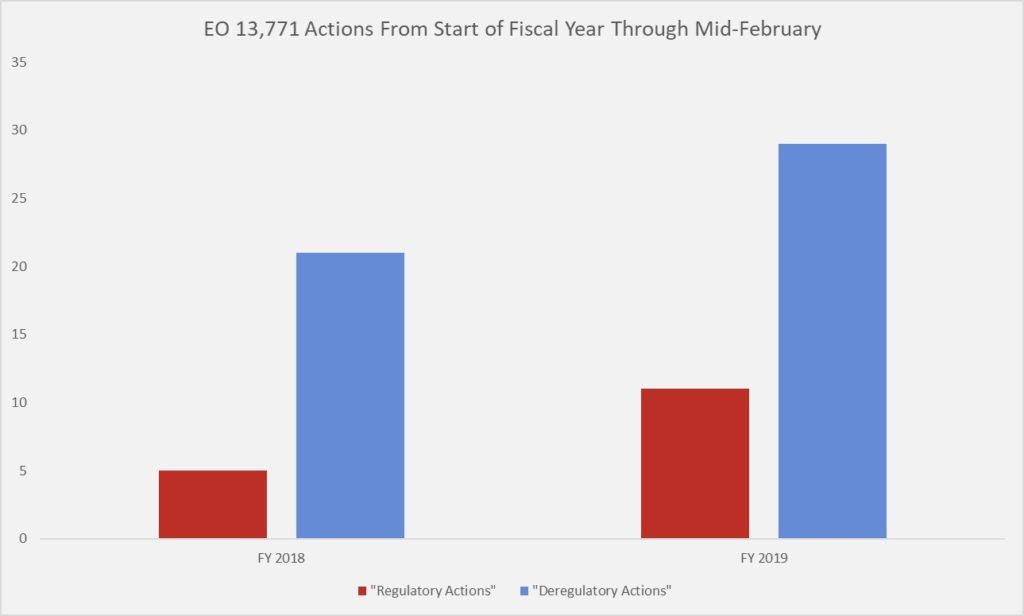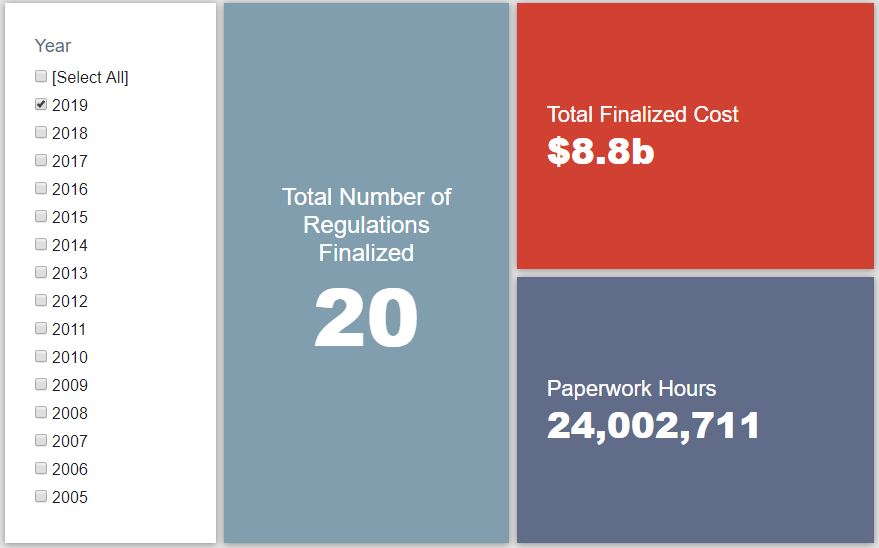Week in Regulation
February 19, 2019
Costs Go Up, but Deregulatory Proposals Emerge
For the third consecutive week, net regulatory costs increased. There were, however, some notable deregulatory actions hitting the pages of the Federal Register. The Environmental Protection Agency (EPA) and Consumer Financial Protection Bureau (CFPB) led the way in this regard. Between both proposed and final rules last week, agencies published $52.8 million in total net costs, but also put forward 4.8 million hours of paperwork reductions.
REGULATORY TOPLINES
- New Proposed Rules: 63
- New Final Rules: 86
- 2019 Total Pages: 4,659
- 2019 Final Rule Costs: $8.8 Billion
- 2019 Proposed Rule Costs: $2.9 Billion
The most significant deregulatory proposal of the week was the “Revised Definition of ‘Waters of the United States’ (WOTUS)” from EPA (in concert with the Army Corps of Engineers). This proposed rule represents the second stage of the Trump Administration’s push to redefine the parameters of WOTUS under the Clean Water Act. The still-pending first stage seeks to return the WOTUS standards to those in place before the Obama Administration’s rule on the matter; this proposal seeks to go even further. The agencies provide a series of estimates based on contingencies involving the first-stage rule and possible state regulatory actions, but this further redefinition could likely lead to $266 million in “forgone costs” annually. While the proposal was technically released in December, its formal publication in the Federal Register starts the clock on its comment period, which is currently set to close on April 15.
The other significant deregulatory proposal from last week comes from CFPB. The proposed rule seeks “to rescind certain provisions of the regulation promulgated by the Bureau in November 2017 governing Payday, Vehicle Title, and Certain High-Cost Installment Loans.” The agency provides a lengthy qualitative discussion on some of the borrower-lender implications of these changes, but the quantified impacts come from more than five million hours in paperwork reductions (and commensurate savings of nearly $90 million). Since this is a proposed rule from an independent agency, its savings do not affect fiscal year (FY) 2019’s regulatory budget under Executive Order (EO) 13,771.
TRACKING THE REGULATORY BUDGET
There was one final rule out of EPA that factored into FY 2019’s regulatory budget under EO 13,771. The rule makes “certain revisions to the National Pollutant Discharge Elimination System permitting regulations proposed on May 18, 2016.” EPA estimates that the clarifications and revisions included therein could save affected entities roughly $2.4 million and nearly 18,000 hours of paperwork each year.
So far in FY 2019 (which began on October 1, 2018), there have been 29 deregulatory actions (per the rubric created by EO 13,771 and the administration’s subsequent guidance document) against 11 rules that increase costs and fall under the EO’s reach. Combined, these actions yield quantified net costs of roughly $10.2 billion. This total, however, includes the caveat regarding the baseline in USDA’s “National Bioengineered Food Disclosure Standard.” If one considers that rule to actually be deregulatory, the administration-wide net total is approximately $3.5 billion in net costs. The administration’s cumulative savings goal for FY 2019 is approximately $18 billion.
THIS WEEK’S REGULATORY PICTURE
One can describe “regulatory policy” in many ways: mundane, opaque, monotonous, complex, legalistic. The list goes on. In order to help provide a clearer and more straight-forward view into this world, the American Action Forum (AAF) will seek to provide a brief illustration of a notable regulatory trend we have identified in a given week. This week’s entry: a snapshot of the relative level of activity under EO 13,771 over the past couple of years.
Per AAF tracking, through the first four and a half months of FY 2019, there has been roughly 1.5 times the amount of EO 13,771 rulemaking activity to this point as there was to the same point in FY 2018 (40 actions with quantified estimates compared to 26, respectively). This demonstrates how much more fully developed the regulatory budget program has become over time. Considering how the shutdown froze essentially one month of FY 2019 in place, this increase in activity is even more notable. As significant proposals continue to wind through the rulemaking process, it will be interesting to see if the gap between these first two full years of regulatory budgeting widens or closes. This trend also comes in light of a recent court ruling that sustained – for the time being, at least – a potential challenge to EO 13,771.
TOTAL BURDENS
Since January 1, the federal government has published $11.7 billion in net costs (with $8.8 billion in finalized costs) and 18.8 million hours of net paperwork burden increases (including roughly 24 million hours from final rules). Click here for the latest Reg Rodeo findings.












